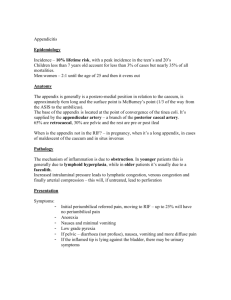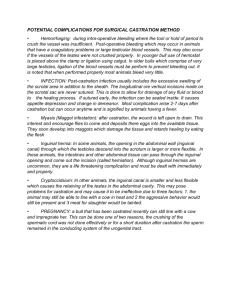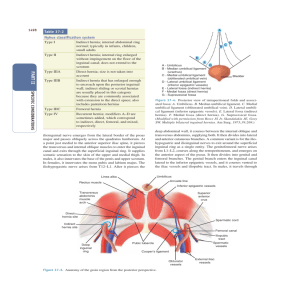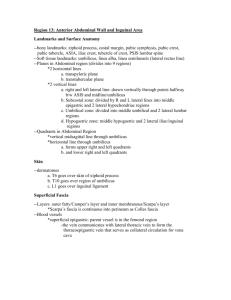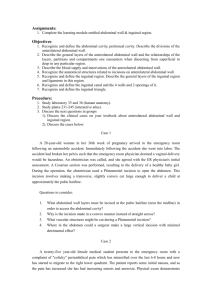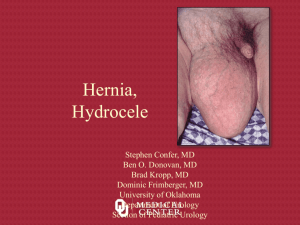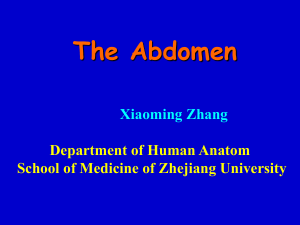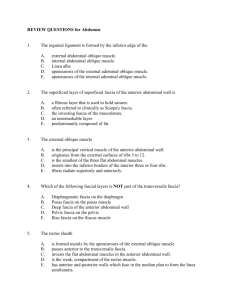Anterior abdominal wall and hernias2015-05
advertisement
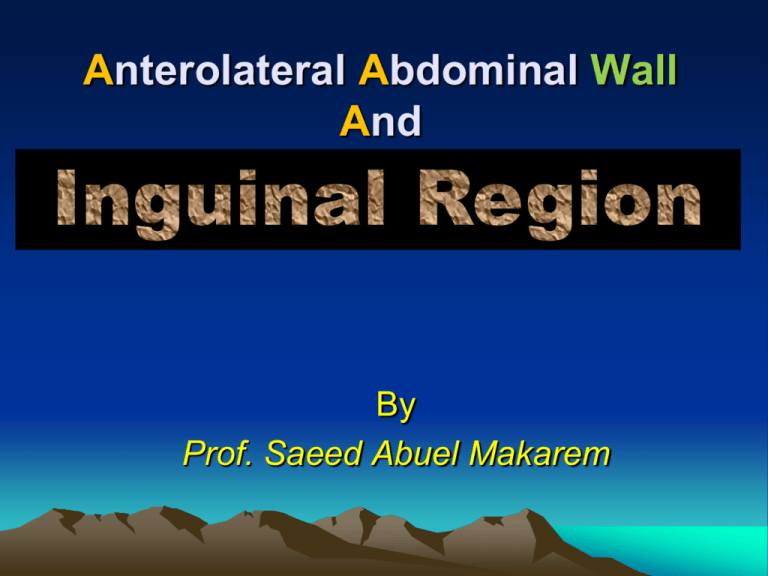
Anterolateral Abdominal Wall And By Prof. Saeed Abuel Makarem Inguinal Region • The groin or the inguinal region, extending between the ASIS and pubic tubercle. • Surgically and anatomically, it is a very important area where structures enter and exit the abdominal cavity. • It is a potential site for Herniation. • In fact, the majority of all abdominal hernias, occur in this region in particular the inguinal hernia, which account for about 80 to 90 % of all abdominal hernias. The transpyloric plane L1 It is a transverse line drawn midway between The suprasternal notch & The symphysis pubis The subcostal plane It is a transverse line drawn between the lowest points of the costal margin The supracrestal plane L4 It is a transverse line drawn between the highest points of the iliac crests The intertubercular plane 5 drawn between a transverse Lline the 2 tubercles of the2 iliac crests The lateral vertical plane A vertical line drawn from The body planes the midclavicular point to the midinguinal point The anterior abdominal wall is divided into 9 regions by 2 transverse lines The transpyloric plane &The intertubercular plane The Rt. & Lt. lateral vertical planes and 2 vertical line divisions of the abdomen The 9 regions are 3 in the middle From above downward Epigastrium Umbilical Hypogastrium 3 on the right side & 3 on the left side From above downward Rt. & Lt. Hypochondrium Rt. & Lt. Lumbar region Rt. & Lt. Iliac region Divisions of the abdomen Layers of anterolateral abdominal wall 1- Skin. 2- Superficial fascia: a- Superficial fatty layer (Camper’s fascia). b- Deep membranous (Scarp’s fascia). NO DEEP FASCIA 4- Muscular layers: a. External oblique. b. Internal oblique. c. Transversus abdominis. 5- Fascia transversalis. 6- Extra peritoneal fatty tissue 7- Parietal peritoneum. External Oblique Origin: Outer surface of lower 8 ribs. Direction of its fibers: Downward, Forward, and Medially. Insertion: Xiphoid process, Linea alba, Symphysis pubis Pubic crest, Pubic tubercle, ASIS. Anterior ½ of outer lip of iliac crest. Layers of the Anterior Abdominal Wall Superficial Inguinal Ring: It’s an oval slit in the lower aponerotic fibers of the External oblique just above & lateral to the pubic tubercle. The lateral crus attaches to pubic tubercle & the medial crus attaches to pubic crest. Its base is formed by the lateral part of pubic crest 1- Skin. 2- Superficial fascia: a- Superficial fatty layer, (Camper’s fascia) b- Deep membranous layer, (Scarpa’s fascia) No Deep Fascia in the anterior abdominal wall 3- External oblique muscle. 4- Internal oblique muscle. 5- Transversus abdominis muscle. 6- Fascia Transversalis. 7- Extraperitoneal fatty Tissue. 8- Peritoneum. Layers of the Anterior Superficial j Abdominal Wall inguinal ring 1- Skin. 2- Superficial fascia: a- Superficial fatty layer, (Camper’s fascia) b- Deep membranous layer, (Scarpa’s fascia) No Deep Fascia in the anterior abdominal wall 3- External oblique muscle. 4- Internal oblique muscle. 5- Transversus abdominis muscle. 6- Fascia Transversalis. 7- Extraperitoneal fatty Tissue. 8- Peritoneum. Femoral ring Internal Oblique Origin: •Lateral 2/3 of inguinal ligament, •Anterior 2/3 of iliac crest, •Lumbar fascia. Direction of its Fibers: upward forward and medially (at right angle with the fibers of external oblique). Insertion: Lower 3 ribs and their costal cartilages, Xiphoid process, Linea alba, Pubic crest and Pectineal line. Transversus Abdominis Origin: • Lateral 1/3 of inguinal ligament, • Anterior 2/3 of inner lip of iliac crest, • Lumber fascia and • Lower 6 costal cartilages. Direction of its fibers: • Horizontally. Insertion: • Xiphoid Process, • Linea alba, • Pubic crest, and • Pectineal line. Deep Inguinal Ring It is an opening in the fascia transversalis 1 cm above the middle of the inguinal ligament (midpoint of inguinal ligament) It lies lateral to the inferior epigastric vessels • It is an oblique intramuscular passage in the lower medial part of the Anterior Abdominal Wall. • It runs just above and parallel to the medial half of the inguinal ligament. • Its length is about 2 inches (5 cm), long in adult. • It connects between the superficial and deep inguinal rings. • Its gives a passage for the spermatic cord in male, or round ligament of the uterus in female. • Also it gives a passage for the Ilioinguinal nerve in both sexes. INGIUNAL CANAL Superficial Inguinal Ring • It’s an oval slit in the lower aponerotic fibers of the external oblique just above & lateral to the pubic . tubercle • The lateral crus attaches to pubic tubercle & the medial crus attaches to pubic crest. Deep Inguinal Ring It is an opening in the fascia transversalis 1 cm above the middle of the inguinal ligament (midpoint of inguinal ligament) It lies lateral to the inferior epigastric vessels Deep ring Superficial inguinal ring INGUINAL CANAL Anterior. Wall: External oblique along whole length Internal oblique along lateral half. Posterior. Wall: Fascia Transversalis along whole length. Conjoint tendon along the medial part. Reflected ligament along the medial part. Ant. Wall: External oblique along whole length Anterior wall: Internal oblique along lateral half. Deep Inguinal Ring: Its an opening in the fascia transversalis 1cm above the middle of the inguinal ligament and lateral to the inferior epigastric vessels. Posterior wall Floor: Roof: Inguinal ligament supported medially by the Lacunar ligament. Arching lower fibers of internal oblique. Boundaries of the Inguinal canal Ant. Wall: External oblique along whole length Internal oblique along lateral half. Post. Wall: Fascia transversalis along whole length. Conjoint tendon along the medial half. Reflected ligament along the medial part. Floor: Inguinal ligament supported medially by the Lacunar ligament. Roof: Arching lower fibers of internal oblique. MECHANICS The inguinal canal is a potential weak point in the anterior abdominal wall. But it posses a protective mechanisms Protective mechanisms • • • • • Oblique transmission.. Anterior wall reinforced laterally by the internal oblique in front of the deep ring. Posterior wall reinforced medially by the conjoint tendon behind the superficial ring. On coughing and straining (micturition and defecation ) the arching lower fibers of the internal oblique and transversus abdominis contract and flatten the roof of the canal, compressing it's content. In great straining (defecation and parturition), the person naturally assumes squatting position, in which the anterior abdominal wall is protected by the thighs. 24 Shutter Mechanism Iliopubic Tract • • • • It is the thickened inferior margin in the fascia transversalis. It appears as a fibrous band running deep (posterior) to the inguinal ligament. During laparoscopy it is seen as it span the subinguinal space, through which the flexors of the hip joint and the neurovascular bundle pass to the lower limb. The inguinal ligament and Iliopubic tract form a bilaminar retinaculum which span an area of weakness in the groin called the myopectineal orifice. The Iliopubic tract demarcates between, the inferior margin of the deep inguinal ring, and the superomedial margin of the femoral ring. It is a useful landmark during laparoscopic repair of inguinal hernia. Internal Surface of the Anterolateral Abdominal Wall The posterior surface of the anterolateral abdominal wall is covered by fascia transversalis. Five umbilical peritoneal folds are seen. 1- Median umbilical fold: Extends from apex of urinary bladder to umbilicus, (obliterated urachus). 2- Two medial umbilical folds: Obliterated distal part of the umbilical artery. 2- Two lateral umbilical folds: the peritoneum cover the Inferior Epigastric vessels, so it bleeds, if it is injured. Fossae in between the Umbilical Folds o Two Supravesical Fossae: On both sides of the median umbilical fold, rare type of external supravesical hernias. o Two Medial Inguinal Fossae: Between medial & Lateral umbilical folds. It is also called inguinal or Hesselbach triangle (direct inguinal hernia) o Two lateral Inguinal fossae: Lateral to lateral umbilical folds (including deep inguinal ring – Indirect or oblique inguinal hernias). ABDOMINAL HERNIAS DEFINITION • A protrusion of part of the abdominal contents outside of the abdomen. PARTS 1. Hernial sac. 2. Contents of the sac. 3. Coverings of the sac. HERNIAL SAC • • It is a pouch of peritoneum (diverticulum) It has a neck and a body. HERNIAL CONTENT • Any mobile structure from the abdominal cavity usually loop of intestine or part of greater omentum. HERNIAL COVERINGS • Formed by the layers of abdominal wall. 31 TYPES OF ABDOMINAL HERNIAE • • • • • • Inguinal- most common- (indirect or direct). Femoral. Umbilical (congenital or acquired). Epigastric. Separation of the two recti abdominis muscles. Internal hernia. 32 INDIRECT OR (OBLIQUE) INGIUINAL HERNIA • Most common form of hernia. • Origin: congenital. • 20 x more common in males. • 30 % bilateral. • More common on the right side, • More common in children and young adults. • Located inside the remains of processus vaginalis. • It's extend depends on the state of obliteration of the processus vaginalis. • Enters the inguinal canal lateral to the inferior epigastric vessels. • Hernial sac lies above and medial to the pubic tubercle • May extend down to the scrotum or (labium majus) 33 DIRECT INGIUINAL HERNIA • 15 % of inguinal herniae • Common in old men with weak abdominal wall, rare in women. • Hernial sac bulges through the posterior wall of the inguinal canal medial to the inferior epigastric vessels • The neck of the hernial sac is wide 34 FEMORAL HERNIA • The hernial sac descends through the femoral canal within femoral sheath. • More common in women. • The neck of the sac lies below and lateral to the pubic tubercle. • The neck of the sac is narrow and lies at the femoral ring. • Because of the narrow neck, it is often irreducible and may become strangulated. 35 UMBILICAL HERNIAE CONGENITAL UMBILICAL HERNIA • Caused by failure of part of the midgut loop to return to the abdominal cavity during fetal development. ACQUIRED INFANTILE UMBILICAL HERNIA • Small hernia caused by a weakness of the umbilical scar at linea alba. • Occurs in children and often disappears without treatment. ACQUIRED UMBILICAL HERNIA OF ADULTS • A paraumbilical hernia. • Caused by a weakness of linea alba in the region of the umbilicus. • More common in women especially with repeated pregnancy. 36 EPIGASTRIC HERNIA • Occurs through the widest part of linea alba • Usually a small hernia • Common in middle-aged manual workers SEPARATION OF THE RECTI ABDOMINIS •The hernial sac lies between the medial margins of the 2 recti •Common in elderly multiparous women. • Caused by a weakness of the recti muscles. INCISIONAL HERNIA • A postoperative complication • Large hernial sac • Causes: - damage to segmental nerve supplying the muscles of the anterior abdominal wall - postoperative infection with necrosis of the muscles 37
